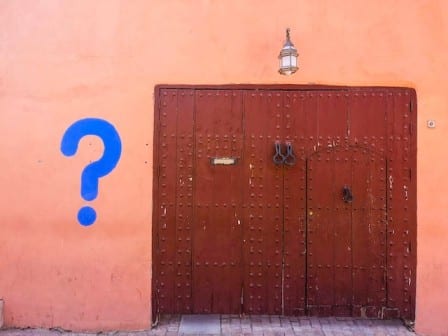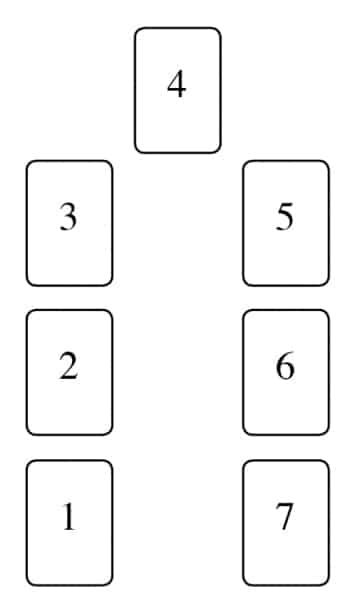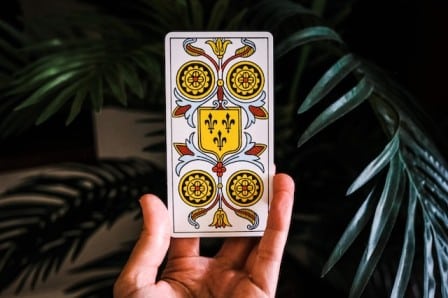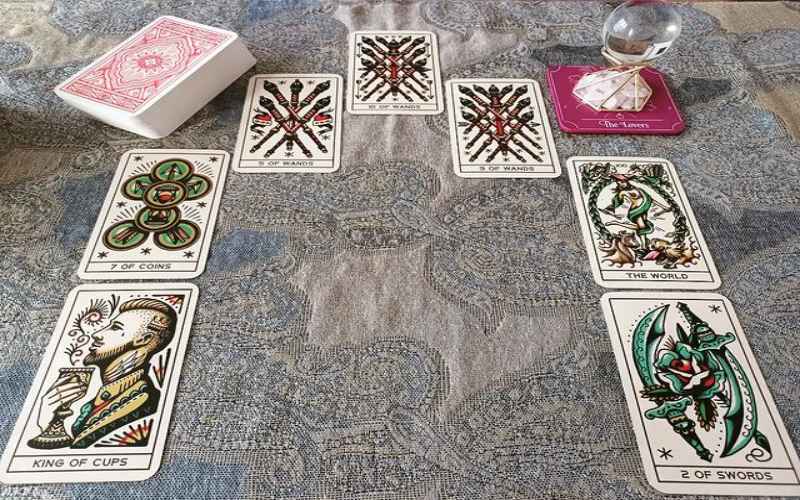For nearly as long as horses have been domesticated, humans have used horseshoes to protect hooves from daily wear. When you receive guidance using the Horseshoe tarot spread, you similarly evoke the protective qualities of this iron band for your future.
Like the classic Celtic Cross, the Horseshoe is an excellent spread for understanding your circumstances and empowering yourself. Unlike the famous ten-card cross, the Horseshoe spread usually consists of seven cards with more flexible meanings, which some readers prefer. In the Horseshoe layout, there’s also more emphasis on developing a plan of action.
It’s not always the right time to do something about a situation. However, you can always use the Horseshoe spread to learn more about your options if you’re ready (or almost ready) to act.
When to Use the Horseshoe Spread?

Because the Horseshoe tarot spread is so focused on next steps, it best serves you when you want to prepare a strategic approach for a specific question. By contrast, the Celtic Cross works equally well for both defined and undefined inquiries.
But this doesn’t mean the Horseshoe spread limits you. Although it’s most effective with a question, the card placement meanings are slightly less rigid. As a result, some tarot readers find it easier to perceive a fluid story in the cards.
In summary, you might consider using this spread when one or more of the following are true:
- You have a specific question in mind.
- You want to learn more about which factors are influencing a specific situation.
- You’re ready to develop a plan or helpful mindset.
- You prefer to read card sequences intuitively, without fixed meanings.
Layout of the Horseshoe Spread
As you might expect, you arrange the seven cards of this layout in the shape of a horseshoe. Therefore, the Horseshoe spread has a “U” or inverted “U” shape with three cards on either side of the card at the turning point.
There’s as much debate about whether to place the open side up or down as there is about how to hang a horseshoe over a door for luck. I usually opt for the inverted “U” for a couple of reasons. Firstly, I appreciate the imagery of a cup pouring luck onto me or the person I’m reading as we strategize. Second, there’s often a feeling in the life of building to a point and then watching events unfold with the momentum of your action, like going up and down a hill.
Ultimately, though, the shape is up to you! My only recommendation is that you can explain to yourself why you’ve chosen your orientation. This intentional energy can help ground your readings with the Horseshoe tarot spread.
Symbolism of the Horseshoe
The story goes that a savvy Irish blacksmith warded evil away by nailing a horseshoe to the devil’s foot. This tale likely led people in the Middle Ages to hang horseshoes over their doors to deter witches from meddling. Now, this superstition is preserved in the belief that the horseshoe brings luck and protection. In addition, iron metal is associated with strength, power, and confidence.
Finally, a traditional horseshoe required seven nails, a magickal number that also symbolizes luck. In numerology, the number seven indicates turning points, making it especially fitting that the Horseshoe spread consists of seven tarot cards.
Parts of the Spread
The Horseshoe spread contains three basic sections:
- Left-side cards: In general, the combination of the first three cards creates a story about the current situation. How did it come to be, and how is it already affecting the future?
- Central card: I often refer to this fourth card as the “turning point,” but other keywords include catalyst, attitude, and advice. It’s in the center because it represents your power to influence the situation.
- Right-side cards: The three cards that follow the central card tell a story about how your action (or inaction) reverberates into the future.
With the Horseshoe spread, understanding the basic flow of the cards in each section can often inspire your reading more than following a strict definition of each card placement. Although I provide suggestions for interpreting each individual card below, I encourage you to deviate at your discretion.
Meaning of Card Positions
The card order and meanings for the Horseshoe spread vary greatly between tarot practitioners. For instance, I’ve seen some readers pull the central card first, and I see all kinds of approaches to the interpretation of that card. I’ve also seen versions of this spread that include only five cards.
If my method supports your intuition, please use it! And if it doesn’t, feel free to change it. Like you’re feasting at a buffet of different tarot philosophies, you can also fill your plate with the elements that work for you—and leave the rest.
First, refer to the diagram below for the order of my card pulls.

For more guidance about interpreting each card according to the method that I use, refer to the table below.
| Card | Card Keyword | Meaning |
| 1 | Past | This card shows which past events are influencing the current situation. |
| 2 | Present | The card that represents the present circumstances is similar to the first card that you pull in a Celtic Cross spread. This card reveals a key aspect of the current matter. |
| 3 | Future | Although this is technically a card about the future, it specifically refers to events that are already set in motion. Like the last tiles in a row of dominoes, these events are consequences of past action. |
| 4 | Advice | I call the central card the Advice card because you’ll return to it often as you formulate an answer to the question. The card that appears could represent initiating action, ceasing action, or changing a mindset. However you interpret it, this card shows how your choices impact what happens next. Therefore, you can also think of the fourth card as a tool or asset, something that empowers you as you move forward. |
| 5 | Environment | Your environment can include people, places, and cultural ideas. In the fifth position, a card can reveal whether elements of your environment are your allies. |
| 6 | Obstacles | After you make your desired changes, you inevitably face challenges. The sixth card gives insight into what those difficulties might be. |
| 7 | Outcome | This card shows the likeliest outcome considering all the current factors. |
Interpreting a Horseshoe Tarot Spread

When you use a Horseshoe spread, you practice two tarot basics:
- Finding the story in the cards
- Using the story to clearly answer a direct question
To hone your magick, you must nurture your own intuitive gifts. So, again I remind you that a strong inkling about the meaning of a card sequence should matter more than what someone on the internet tells you to think.
However, I find it can be helpful to share ideas about where to look for key information. In tarot spreads, different card combinations create a potential map for your interpretation.
Important Card Combinations
In the Horseshoe spread, the following tarot card combinations add context to your reading:
- Interpret cards 1, 2, and 3 together before you look at the other cards in the spread. Try to sense the story in them without getting too stuck on which point in time each card represents. Don’t doubt yourself if you feel that card 3 indicates a past (not future) influence—you might find that the past is repeating itself, and your awareness of that could be the key to finding a resolution.
- By comparing cards 5 (Environment) and 6 (Obstacles), you can discover the extent that your environment presents a challenge. If these cards have similar energies, then external forces might have a significant influence over the situation. If card 5 is very different from card 6, then you can consider how to use positive environmental influences to your advantage.
- If card 7 (Outcome) is unfavorable or confusing, pair it with card 4 (Advice). The assets associated with the fourth card will help you achieve the desired outcome.
Another way to find helpful pairings is to group the cards that are across from one another in the “U” shape:
- Card 1 (Past) and card 7 (Outcome) can reveal how much the past dictates the future. Understanding this connection helps you release the past if necessary.
- Card 2 (Present) and card 6 (Obstacles) operate much like the small cross in the Celtic Cross spread. Together, they show the basic situation: what’s happening and what stands in the way of what you want.
- Card 3 (Future) and card 5 (Environment) illustrate possible alliances going forward, as well as the people and places who don’t support you.
Frequently Asked Questions (FAQs)
The Horseshoe spread isn’t usually the first spread that tarot readers learn. For that you should rather check out our guide on easy three card spreads. As a result, you might have several questions as you practice using this spread. Consider the answers to some of the most common questions below.
Yes! Just as you can with any other tarot spread, you can use the Horseshoe spread to analyze one of your own questions.
The Horseshoe spread is best for a specific question. While the Celtic Cross captures a situation, like a photograph, the Horseshoe helps you find your way through a situation, like a map. Therefore, the Horseshoe spread is especially helpful for developing a plan of action.
Finally, tarot readers who prefer reading within a more fluid framework might appreciate the suggested but loose structure of the Horseshoe.
Though some versions of this spread involve only five cards, you typically pull seven cards for the Horseshoe spread.
Many readers consider the Horseshoe tarot spread more accessible than the ten-card Celtic Cross spread. Overall, the seven-card Horseshoe spread is simpler than many sequences but still more complex than some of the basic one-card and three-card pulls.
Over time, a strong tarot reader will develop ease with all of these spreads, but you can start practicing at any stage.
You should have a specific question about your circumstances when you use a Horseshoe spread. You should also be open to advice and ready to make changes.
A reversed outcome card isn’t necessarily negative. Sometimes, however, a reversal can mute the positive expression of certain cards. When this happens, look to the fourth card of the Horseshoe spread to learn how to prevent a dissatisfying result.
Featured Image Credit: fortunesandholistics

